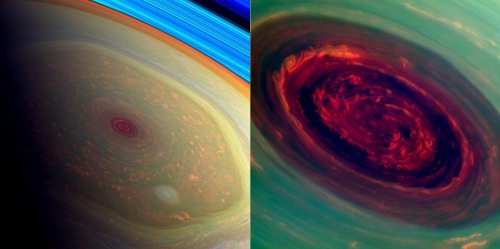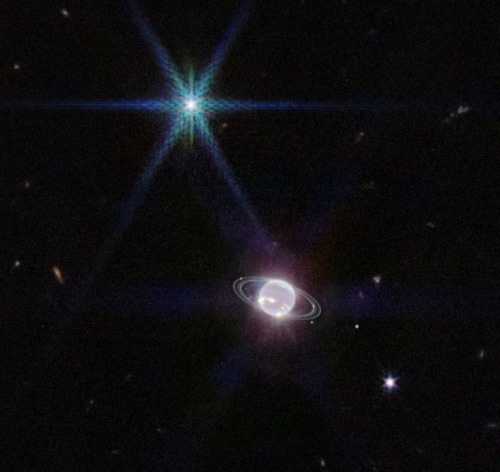Official Video With Credit Where Appropriate For The Above Images.
Official video with credit where appropriate for the above images.

Saturn’s hexagonal storm system in it’s north pole
More Posts from Night-hides-the-world and Others
Hubble has discovered a dwarf star that devours its own solar system. It's like a cosmic cannibal

Astronomers used archival data from the Hubble Space Telescope and other observatories to analyze the spectral properties of the white dwarf star G238-44.
Detected elements show that the dead star swallows debris from both the inside and the outside of its system. It's a case of "cosmic cannibalism," say the study's authors, published on the Hubble Telescope website.
G238-44 was a Sun-like star that lost its outer layers and no longer burned fuel through nuclear fusion. The discovery that stellar debris simultaneously captures matter from its asteroid belt and Kuiper belt-like regions at the edge of the solar system, including ice bodies, is significant because it suggests that a "water tank" may be a common feature in outer areas. of planetary systems.
‼️When a star like the Sun expands and becomes a red giant, at the end of its life, it loses mass by releasing its outer layers.
➡️A consequence of this may be the gravitational scattering of small objects, such as asteroids, comets and satellites, to the large planets in the system. Hit in this way, surviving objects can be thrown into very eccentric orbits.‼️
☑️ "After the phase of the red giant, the remaining white dwarf star is compact - no bigger than Earth. The planets get very close to the star and experience strong forces of attraction that break them to pieces, creating a disk of gas and dust that eventually falls on the surface of the white dwarf star, "said Johnson.




Another comic for assorted planets month!
Time for a comic about Jupiter!
http://www.space.com/7-jupiter-largest-planet-solar-system.html


NASA released the clearest images of Neptune’s rings in over 30 years.
Spaceships Don’t Go to the Moon Until They’ve Gone Through Ohio
From the South, to the Midwest, to infinity and beyond. The Orion spacecraft for Artemis I has several stops to make before heading out into the expanse, and it can’t go to the Moon until it stops in Ohio. It landed at the Mansfield Lahm Regional Airport on Nov. 24, and then it was transferred to Plum Brook Station where it will undergo a series of environmental tests over the next four months to make sure it’s ready for space. Here are the highlights of its journey so far.

It’s a bird? It’s a whale? It’s the Super Guppy!
The 40-degree-and-extremely-windy weather couldn’t stop the massive crowd at Mansfield from waiting hours to see the Super Guppy land. Families huddled together as they waited, some decked out in NASA gear, including one astronaut costume complete with a helmet. Despite the delays, about 1,500 people held out to watch the bulbous airplane touch down.

Buckle up. It’s time for an extremely safe ride.
After Orion safely made it to Ohio, the next step was transporting it 41 miles to Plum Brook Station. It was loaded onto a massive truck to make the trip, and the drive lasted several hours as it slowly maneuvered the rural route to the facility. The 130-foot, 38-wheel truck hit a peak speed of about 20 miles per hour. It was the largest load ever driven through the state, and more than 700 utility lines were raised or moved in preparation to let the vehicle pass.

Calling us clean freaks would be an understatement.
Any person who even thinks about breathing near Orion has to be suited up. We’re talking “bunny” suit, shoe covers, beard covers, hoods, latex gloves – the works. One of our top priorities is keeping Orion clean during testing to prevent contaminants from sticking to the vehicle’s surface. These substances could cause issues for the capsule during testing and, more importantly, later during its flight around the Moon.

And liftoff of Orion… via crane.
On the ceiling of the Space Environments Complex at Plum Brook Station is a colossal crane used to move large pieces of space hardware into position for testing. It’s an important tool during pretest work, as it is used to lift Orion from the “verticator”—the name we use for the massive contraption used to rotate the vehicle from its laying down position into an upright testing orientation. After liftoff from the verticator, technicians then used the crane to install the spacecraft inside the Heat Flux System for testing.

It’s really not tin foil.
Although it looks like tin foil, the metallic material wrapped around Orion and the Heat Flux System—the bird cage-looking hardware encapsulating the spacecraft—is a material called Mylar. It’s used as a thermal barrier to help control which areas of the spacecraft get heated or cooled during testing. This helps our team avoid wasting energy heating and cooling spots unnecessarily.
Bake at 300° for 63 days.
It took a little over a week to prep Orion for its thermal test in the vacuum chamber. Now begins the 63-day process of heating and cooling (ranging from -250° to 300° Fahrenheit) the capsule to ensure it’s ready to withstand the journey around the Moon and back.
View more images of Orion’s transportation and preparation here.
Make sure to follow us on Tumblr for your regular dose of space: http://nasa.tumblr.com.
Solar System 10 Things: Looking Back at Pluto
In July 2015, we saw Pluto up close for the first time and—after three years of intense study—the surprises keep coming. “It’s clear,” says Jeffery Moore, New Horizons’ geology team lead, “Pluto is one of the most amazing and complex objects in our solar system.”
1. An Improving View

These are combined observations of Pluto over the course of several decades. The first frame is a digital zoom-in on Pluto as it appeared upon its discovery by Clyde Tombaugh in 1930. More frames show of Pluto as seen by the Hubble Space Telescope. The final sequence zooms in to a close-up frame of Pluto taken by our New Horizons spacecraft on July 14, 2015.
2. The Heart

Pluto’s surface sports a remarkable range of subtle colors are enhanced in this view to a rainbow of pale blues, yellows, oranges, and deep reds. Many landforms have their own distinct colors, telling a complex geological and climatological story that scientists have only just begun to decode. The image resolves details and colors on scales as small as 0.8 miles (1.3 kilometers). Zoom in on the full resolution image on a larger screen to fully appreciate the complexity of Pluto’s surface features.
3. The Smiles

July 14, 2015: New Horizons team members Cristina Dalle Ore, Alissa Earle and Rick Binzel react to seeing the spacecraft’s last and sharpest image of Pluto before closest approach.
4. Majestic Mountains

Just 15 minutes after its closest approach to Pluto, the New Horizons spacecraft captured this near-sunset view of the rugged, icy mountains and flat ice plains extending to Pluto’s horizon. The backlighting highlights more than a dozen layers of haze in Pluto’s tenuous atmosphere. The image was taken from a distance of 11,000 miles (18,000 kilometers) to Pluto; the scene is 780 miles (1,250 kilometers) wide.
5. Icy Dunes

Found near the mountains that encircle Pluto’s Sputnik Planitia plain, newly discovered ridges appear to have formed out of particles of methane ice as small as grains of sand, arranged into dunes by wind from the nearby mountains.
6. Glacial Plains

The vast nitrogen ice plains of Pluto’s Sputnik Planitia – the western half of Pluto’s “heart”—continue to give up secrets. Scientists processed images of Sputnik Planitia to bring out intricate, never-before-seen patterns in the surface textures of these glacial plains.
7. Colorful and Violent Charon

High resolution images of Pluto’s largest moon, Charon, show a surprisingly complex and violent history. Scientists expected Charon to be a monotonous, crater-battered world; instead, they found a landscape covered with mountains, canyons, landslides, surface-color variations and more.
8. Ice Volcanoes

One of two potential cryovolcanoes spotted on the surface of Pluto by the New Horizons spacecraft. This feature, known as Wright Mons, was informally named by the New Horizons team in honor of the Wright brothers. At about 90 miles (150 kilometers) across and 2.5 miles (4 kilometers) high, this feature is enormous. If it is in fact an ice volcano, as suspected, it would be the largest such feature discovered in the outer solar system.
9. Blue Rays

Pluto’s receding crescent as seen by New Horizons at a distance of 120,000 miles (200,000 kilometers). Scientists believe the spectacular blue haze is a photochemical smog resulting from the action of sunlight on methane and other molecules in Pluto’s atmosphere. These hydrocarbons accumulate into small haze particles, which scatter blue sunlight—the same process that can make haze appear bluish on Earth.
10. Encore

On Jan. 1, 2019, New Horizons will fly past a small Kuiper Belt Object named MU69 (nicknamed Ultima Thule)—a billion miles (1.5 billion kilometers) beyond Pluto and more than four billion miles (6.5 billion kilometers) from Earth. It will be the most distant encounter of an object in history—so far—and the second time New Horizons has revealed never-before-seen landscapes.
Make sure to follow us on Tumblr for your regular dose of space: http://nasa.tumblr.com.
![A Multi-Camera 360° Panoramic Timelapse Of The Stars By Vincent Brady [VIDEO]](https://64.media.tumblr.com/4e12ed79b6fa93fbd2f17ccd004921d6/tumblr_n7h573O5RR1rte5gyo1_500.gif)
A Multi-Camera 360° Panoramic Timelapse of the Stars by Vincent Brady [VIDEO]

The phases of Venus as it orbits the Sun, illustrated by John Emslie in Astronomical Diagrams, 1851.
The Perseid Meteor Shower Is Here!

Image Credit: NASA/Bill Ingalls
The Perseids are at their peak this week!
The Perseid meteor shower, one of the biggest meteor showers of the year, will be at its brightest early in the morning on Wednesday, August 12. Read on for some tips on how to watch the night sky this week – and to find out: what exactly are the Perseids, anyway?

Credit: NASA/Bill Ingalls
Your best chance to spot the Perseids will be between 2 AM and dawn (local time) the morning of August 12. Find a dark spot, avoid bright lights (yes, that includes your phone) and get acclimated to the night sky.
Your eyes should be at peak viewing capacity after about 30 minutes; though the Moon may block out some of the dimmer meteors, you should still be able to see up to 15-20 an hour. If you’re not an early bird, you can try and take a look soon after sunset (around 9 PM) on the 11th, though you may not see as many Perseids then.

Credit: NASA/MEO
If it’s too cloudy, or too bright, to go skywatching where you are, you can try again Wednesday or Thursday night – or just stay indoors and watch the Perseids online!
Our Meteor Watch program will be livestreaming the Perseids from Huntsville, Alabama on Facebook (weather permitting), starting around 9 p.m. EDT on August 11 and continuing through sunrise.
So… why are they called the Perseids?
Because all of a meteor shower’s meteors have similar orbits, they appear to come from the same place in the sky – a point called the radiant.

The radiant for the Perseids, as you might guess from the name, is in the constellation Perseus, found near Aries and Taurus in the night sky.
But they’re not actually coming from Perseus, right?

Credit: NASA/Joel Kowsky
Right! The Perseids are actually fragments of the comet Swift-Tuttle, which orbits within our solar system.
If you want to learn more about the Perseids, visit our Watch the Skies blog or check out our monthly “What’s Up” video series. Happy viewing!
Make sure to follow us on Tumblr for your regular dose of space: http://nasa.tumblr.com
-
 flyingincircles liked this · 2 weeks ago
flyingincircles liked this · 2 weeks ago -
 eyesra liked this · 1 month ago
eyesra liked this · 1 month ago -
 mismaxx reblogged this · 1 month ago
mismaxx reblogged this · 1 month ago -
 ivylesbian reblogged this · 1 month ago
ivylesbian reblogged this · 1 month ago -
 salmonid-carcass liked this · 2 months ago
salmonid-carcass liked this · 2 months ago -
 onox liked this · 2 months ago
onox liked this · 2 months ago -
 admiralanteater liked this · 2 months ago
admiralanteater liked this · 2 months ago -
 bearlydefault reblogged this · 2 months ago
bearlydefault reblogged this · 2 months ago -
 laying-on-the-floor-is-nice reblogged this · 2 months ago
laying-on-the-floor-is-nice reblogged this · 2 months ago -
 peepantskitty liked this · 2 months ago
peepantskitty liked this · 2 months ago -
 shmergaberg reblogged this · 2 months ago
shmergaberg reblogged this · 2 months ago -
 whatdouwanth reblogged this · 2 months ago
whatdouwanth reblogged this · 2 months ago -
 whatdouwanth liked this · 2 months ago
whatdouwanth liked this · 2 months ago -
 alishbiceps reblogged this · 2 months ago
alishbiceps reblogged this · 2 months ago -
 alishbiceps liked this · 2 months ago
alishbiceps liked this · 2 months ago -
 m3ybuz reblogged this · 2 months ago
m3ybuz reblogged this · 2 months ago -
 dreamersbbq liked this · 2 months ago
dreamersbbq liked this · 2 months ago -
 ramblingmeow11 liked this · 2 months ago
ramblingmeow11 liked this · 2 months ago -
 paperpiperpeeperpopper liked this · 2 months ago
paperpiperpeeperpopper liked this · 2 months ago -
 fleshtornado reblogged this · 2 months ago
fleshtornado reblogged this · 2 months ago -
 xyw reblogged this · 2 months ago
xyw reblogged this · 2 months ago -
 ruby-the-scholar reblogged this · 2 months ago
ruby-the-scholar reblogged this · 2 months ago -
 syzygyblvd liked this · 2 months ago
syzygyblvd liked this · 2 months ago -
 mothmanbignaturals liked this · 2 months ago
mothmanbignaturals liked this · 2 months ago -
 wokrs-of-whimsy liked this · 2 months ago
wokrs-of-whimsy liked this · 2 months ago -
 babypowdercocaine reblogged this · 2 months ago
babypowdercocaine reblogged this · 2 months ago -
 fieryheart959 liked this · 3 months ago
fieryheart959 liked this · 3 months ago -
 apawmeownyation reblogged this · 3 months ago
apawmeownyation reblogged this · 3 months ago -
 apawmeownyation liked this · 3 months ago
apawmeownyation liked this · 3 months ago -
 chicabeta reblogged this · 3 months ago
chicabeta reblogged this · 3 months ago -
 chicabeta liked this · 3 months ago
chicabeta liked this · 3 months ago -
 lichspawns reblogged this · 3 months ago
lichspawns reblogged this · 3 months ago -
 lichspawns liked this · 3 months ago
lichspawns liked this · 3 months ago -
 silverystormwing liked this · 3 months ago
silverystormwing liked this · 3 months ago -
 zippycat9 liked this · 3 months ago
zippycat9 liked this · 3 months ago -
 is-this-where-the-line-starts liked this · 3 months ago
is-this-where-the-line-starts liked this · 3 months ago -
 hikainofan reblogged this · 3 months ago
hikainofan reblogged this · 3 months ago -
 rainbowbutterflyp liked this · 3 months ago
rainbowbutterflyp liked this · 3 months ago -
 brittiedoodles reblogged this · 3 months ago
brittiedoodles reblogged this · 3 months ago -
 brittie-doodles liked this · 3 months ago
brittie-doodles liked this · 3 months ago -
 interdimentional liked this · 3 months ago
interdimentional liked this · 3 months ago -
 oedonchapeldweller reblogged this · 3 months ago
oedonchapeldweller reblogged this · 3 months ago -
 akireu-13 liked this · 3 months ago
akireu-13 liked this · 3 months ago -
 sailorskunk liked this · 3 months ago
sailorskunk liked this · 3 months ago -
 thinecottagecorebitch reblogged this · 3 months ago
thinecottagecorebitch reblogged this · 3 months ago -
 freddykicksasses liked this · 3 months ago
freddykicksasses liked this · 3 months ago -
 literallyjusttrashposting reblogged this · 3 months ago
literallyjusttrashposting reblogged this · 3 months ago
Astronomy and the other wonders you witness when you look to the skies.
115 posts

